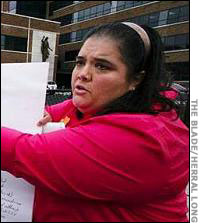By Seamus McGraw
Court TV
May 10, 2006
http://www.crimelibrary.com/news/original/0506/1002_chet_warren.html
TOLEDO, Ohio (Crime Libarary) — If nothing else, advocates for survivors of sexual abuse by priests had hoped that the steady drumbeat of media attention focused by allegations of bizarre rituals and depraved assaults against children, committed, they maintained, over three decades by disgraced priest Chet Warren and others, would in the end lead the state legislature and the church to greater accountability.
It was clear, said Claudia Vercellotti, an activist with the Toledo chapter of SNAP, that law enforcement could do little, the allegations were too old, and whatever hard evidence there may have been about the claims had long since been obscured or erased by time.
But the advocates still held out hope that the state legislature might act. But in the end, Vercellotti says, they were disappointed even there.
 |
| Claudia Vercellotti |
Though after a lengthy delay, the Ohio State legislature last week finally passed a controversial bill that would extend the statute of limitations for civil suits filed against abusers, Vercellotti and others say the new measure falls far short of their expectations. They contend their hopes for an even more aggressive bill were effectively "gutted" by opposition from the state's Catholic bishops.
Page Two
Currently, Ohio law requires that such suits be filed within two years of the time the victim turns eighteen. The new measure would extend that to 12 years.
But a key provision of the bill a measure that would allow victims to file suit against the church for claims dating back 35 years was stricken from the final version that passed the legislature, in large part, according to published reports, because of opposition from the state's bishops and through their lobbying arm, the Catholic Conference of Ohio. The church had argued that the original measure would have been unconstitutional.
Civil registration provisions unclear
In its place, lawmakers substituted a measure that would allow victims to take their alleged abusers to court and sue to have their names placed on a civil registry, similar to those mandated around the country by Megan's Law. But as Bill Frogameni, a freelance writer put it in the National Catholic Reporter, critics have charged that the law is vague about "how the provision would work in practice," and Vercellotti and others have complained that the revised law removes a key incentive the threat of financial penalties — for the church to take aggressive action against accused priests, whose alleged crimes often go unreported until years, sometimes even decades after the window for legal action closes.
What's more, Vercellotti and others say they are troubled by what they deem to be a serious loophole in the new law. Under the newly passed bill, clerics are not required to report suspected abuse if they learn about it in the context of a "sacred trust" relationship. While some advocates of the new bill have argued that the provision is designed to protect the sanctity of the confessional, some critics have warned that the provision is overly broad and could be interpreted to include almost anything a cleric learns while acting as a spiritual advisor, even if the information is passed outside the confessional.
Page Three
In a written statement issued shortly after the measure was adopted, the Catholic Conference praised the new law saying that it would be a valuable tool in protecting the state's children "from sexual abuse now and in the future."
The measure is currently under legal review, and Gov. Bob Taft has signaled that he intends to sign it into law.
But Vercellotti, together with SNAP officials from Cincinnati have filed lawsuits challenging the new law. It is not clear whether the pending legal action will block the governor from signing the law.
Any original material on these pages is copyright © BishopAccountability.org 2004. Reproduce freely with attribution.